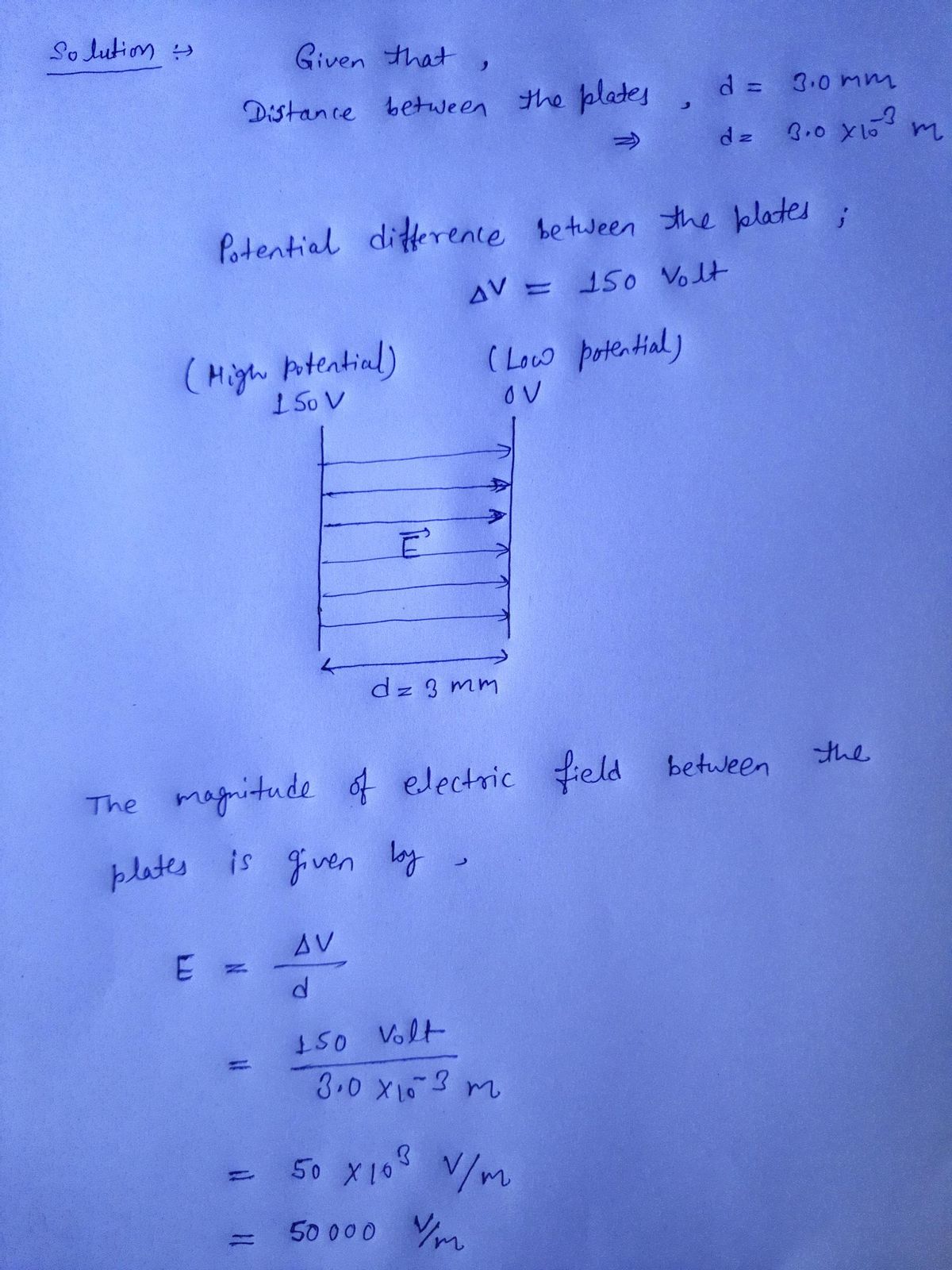College Physics
11th Edition
ISBN:9781305952300
Author:Raymond A. Serway, Chris Vuille
Publisher:Raymond A. Serway, Chris Vuille
Chapter1: Units, Trigonometry. And Vectors
Section: Chapter Questions
Problem 1CQ: Estimate the order of magnitude of the length, in meters, of each of the following; (a) a mouse, (b)...
Related questions
Concept explainers
Dielectric Constant Of Water
Water constitutes about 70% of earth. Some important distinguishing properties of water are high molar concentration, small dissociation constant and high dielectric constant.
Electrostatic Potential and Capacitance
An electrostatic force is a force caused by stationary electric charges /fields. The electrostatic force is caused by the transfer of electrons in conducting materials. Coulomb’s law determines the amount of force between two stationary, charged particles. The electric force is the force which acts between two stationary charges. It is also called Coulomb force.
Question
![**Title: Calculating the Electric Field in a Capacitor**
**Objective:**
Determine the magnitude and direction of the electric field for the given capacitor setup.
**Description:**
The diagram illustrates a parallel plate capacitor. The left plate is connected to 150 V, and the right plate is connected to 0 V. The distance between the plates is indicated as 3.0 mm. The spacing between specific points is marked as 1.0 mm segments.
**Analysis:**
1. **Potential Difference (ΔV):**
- The potential difference between the plates is calculated as:
\[
\Delta V = 150 \, \text{V} - 0 \, \text{V} = 150 \, \text{V}
\]
2. **Distance Between Plates (d):**
- The given distance between the plates is 3.0 mm, which can be converted to meters for standard SI units:
\[
d = 3.0 \, \text{mm} = 0.003 \, \text{m}
\]
3. **Electric Field (E):**
- The electric field (E) between the plates of the capacitor can be calculated using the formula:
\[
E = \frac{\Delta V}{d} = \frac{150 \, \text{V}}{0.003 \, \text{m}} = 50,000 \, \text{V/m}
\]
4. **Direction of the Electric Field:**
- The electric field direction is from the positive plate (150 V) to the negative plate (0 V).
**Conclusion:**
- **Magnitude of the Electric Field:** 50,000 V/m
- **Direction:** From left (150 V) to right (0 V)
This analysis of the capacitor helps understand basic electric field concepts and their calculation in electrostatics.](/v2/_next/image?url=https%3A%2F%2Fcontent.bartleby.com%2Fqna-images%2Fquestion%2F070e8b65-931e-44e7-bfb4-6d69e5ced655%2Ffe96cb42-e3d4-46f8-8ee4-af7b234fe2e1%2Fpipde1o_processed.jpeg&w=3840&q=75)
Transcribed Image Text:**Title: Calculating the Electric Field in a Capacitor**
**Objective:**
Determine the magnitude and direction of the electric field for the given capacitor setup.
**Description:**
The diagram illustrates a parallel plate capacitor. The left plate is connected to 150 V, and the right plate is connected to 0 V. The distance between the plates is indicated as 3.0 mm. The spacing between specific points is marked as 1.0 mm segments.
**Analysis:**
1. **Potential Difference (ΔV):**
- The potential difference between the plates is calculated as:
\[
\Delta V = 150 \, \text{V} - 0 \, \text{V} = 150 \, \text{V}
\]
2. **Distance Between Plates (d):**
- The given distance between the plates is 3.0 mm, which can be converted to meters for standard SI units:
\[
d = 3.0 \, \text{mm} = 0.003 \, \text{m}
\]
3. **Electric Field (E):**
- The electric field (E) between the plates of the capacitor can be calculated using the formula:
\[
E = \frac{\Delta V}{d} = \frac{150 \, \text{V}}{0.003 \, \text{m}} = 50,000 \, \text{V/m}
\]
4. **Direction of the Electric Field:**
- The electric field direction is from the positive plate (150 V) to the negative plate (0 V).
**Conclusion:**
- **Magnitude of the Electric Field:** 50,000 V/m
- **Direction:** From left (150 V) to right (0 V)
This analysis of the capacitor helps understand basic electric field concepts and their calculation in electrostatics.

Transcribed Image Text:The image displays a diagram at the top with two rectangles on either side, representing plates, separated by three spaces each measuring 1.0 mm across, summing up to a total distance of 3.0 mm between the plates.
Below the diagram, a question poses multiple-choice options regarding the electric field strength and direction between the plates:
- ○ 450,000 V/m, to the right
- ○ 50 V/m to the right
- ○ 50,000 V/m, to the left
- ○ 450,000 V/m, to the left
- ○ 50 V/m to the left
- ○ 50,000 V/m, to the right
This setup is typically used to ask about electric field calculations in physics, focusing on concepts like field strength, direction, and distance between charged plates.
Expert Solution
Step 1

Step by step
Solved in 2 steps with 2 images

Knowledge Booster
Learn more about
Need a deep-dive on the concept behind this application? Look no further. Learn more about this topic, physics and related others by exploring similar questions and additional content below.Recommended textbooks for you

College Physics
Physics
ISBN:
9781305952300
Author:
Raymond A. Serway, Chris Vuille
Publisher:
Cengage Learning

University Physics (14th Edition)
Physics
ISBN:
9780133969290
Author:
Hugh D. Young, Roger A. Freedman
Publisher:
PEARSON

Introduction To Quantum Mechanics
Physics
ISBN:
9781107189638
Author:
Griffiths, David J., Schroeter, Darrell F.
Publisher:
Cambridge University Press

College Physics
Physics
ISBN:
9781305952300
Author:
Raymond A. Serway, Chris Vuille
Publisher:
Cengage Learning

University Physics (14th Edition)
Physics
ISBN:
9780133969290
Author:
Hugh D. Young, Roger A. Freedman
Publisher:
PEARSON

Introduction To Quantum Mechanics
Physics
ISBN:
9781107189638
Author:
Griffiths, David J., Schroeter, Darrell F.
Publisher:
Cambridge University Press

Physics for Scientists and Engineers
Physics
ISBN:
9781337553278
Author:
Raymond A. Serway, John W. Jewett
Publisher:
Cengage Learning

Lecture- Tutorials for Introductory Astronomy
Physics
ISBN:
9780321820464
Author:
Edward E. Prather, Tim P. Slater, Jeff P. Adams, Gina Brissenden
Publisher:
Addison-Wesley

College Physics: A Strategic Approach (4th Editio…
Physics
ISBN:
9780134609034
Author:
Randall D. Knight (Professor Emeritus), Brian Jones, Stuart Field
Publisher:
PEARSON